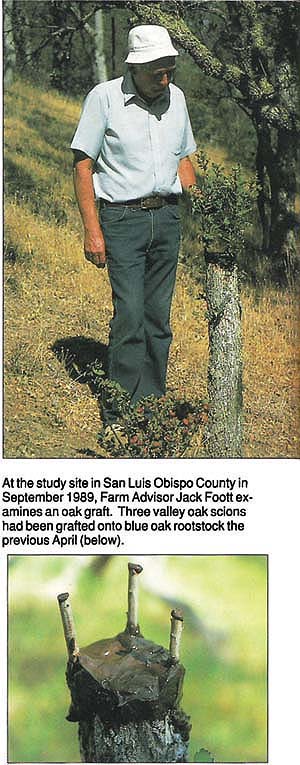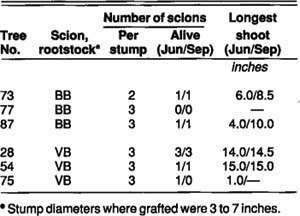All Issues
Grafting California native oaks
Publication Information
California Agriculture 44(2):30-31.
Published March 01, 1990
PDF | Citation | Permissions
Abstract
Preliminary results of grafting blue oak and valley oak scions to blue oak rootstock are encouraging. It appears that grafting of California native oaks has potential research and management applications.
Full text
Californians have become increasingly concerned about loss of native oak trees and their contribution to the state's natural beauty, wildlife habitat, and economy. During the past century, some oak species have not regenerated well in some parts of the state, especially blue oak (Quercus douglasii), valley oak (Q. lobata), and Engelmann oak (Q. engelmannii). Acorns and seedling oaks are often trampled or eaten by livestock. Since European settlement of California, deer (Odocoileus hemionus) and small rodents, which feed on acorns and seedlings, have increased in number. Mediterranean annual grasses, introduced in the mid-1700s, have gradually replaced native perennial bunch grasses. There is increasing evidence that Mediterranean annuals inhibit oak regeneration by competing for available space and soil moisture. Poor regeneration is only part of the problem: in the past 20 years, residential and commercial development has occurred on over 275,000 acres of oak rangeland, and use of native oak trees for firewood has increased.
The University of California and the California Department of Forestry and Fire Protection, under the auspices of the Integrated Hardwood Range Management Program, currently fund studies of several aspects of the oak problem. A principal focus is oak regeneration. On the site of a stump-sprouting study in southern San Luis Obispo County, a deer-proof fence was constructed around 1-1/2 acres of dense blue oak. Availability of an enclosed area protected from foraging by deer and livestock provided us with an opportunity to explore whether blue oak could be grafted successfully in successfully in oak rangelands.
Study area
The blue oak grafting site is on a private ranch in San Luis Obispo County about 6 miles southeast of Pozo, California. Average monthly temperatures range from about 43°F in January to 70°F in July. Average annual rainfall totals 20 inches. Typically, no rain occurs during May to October. Sandy-loam soils dominate the area.
Blue oak occupies many of the hillsides, and valley oak and coast live oak (Q. agrifolia) are scattered over the more moist valleys and gently rolling areas. Western sycamore (Platanus racemosa) and digger pine (Pinus sabiniana) are frequently interspersed with the oaks. Woody understory vegetation consists mostly of toyon (Arctostaphylos spp.), and poison oak (Rhus diversilova). Forbs and annual grasses occupy the woodland floors and grassy open areas.
Methods
Because rainfall was low during the previous 3 years, blue and valley oak trees on the study site did not produce suitable scion wood for grafting in 1989. We therefore collected scion wood (current season's growth) on March 8 about 20 miles from the study area along a county road where runoff had provided better growing conditions. Scion wood, averaging 1/4 inch in diameter at the cut end and 2 feet in length, was taken from branches of small blue and valley oak trees. Immediately after harvest, the wood was put in a portable ice chest and, upon return from the field, stored for about a month in a refrigerator at 37°F.
Leaf flush occurred among blue oaks on the study site in early April. On April 7, just before grafting, six 3- to 8-inch-diameter blue oak rootstock trees were cut at about a 3-foot stump height, and 4-inch-long scions were cut from the scion wood collected in March. Each scion had several buds.
Blue oak scions were grafted onto three of the blue oak stumps and valley oak scions onto the three other stumps. Except for one blue oak stump grafted with two scions, three scions were grafted per stump. We used the modified bark grafting technique (as described in Propagation of Temperatezone Fruit Plants, Leaflet 21103, by H.T. Hartmann and J.A. Beutel, UC Division of Agriculture and Natural Resources). After grafting, an asphalt sealant was applied to the cut surfaces of the stumps and scions to minimize water loss and potential infection.
Preliminary results
We measured scion shoots on June 23 and September 12 (table 1). In June, scion growth was present on two of the three stumps grafted with valley oak. Two of eight blue oak scions had shoots, one on each of two stumps. One scion had two and the other three shoots; the longest shoot was 6 inches. Five of the nine valley oak scions had shoots, one each on two of the stumps and all three on the third stump. Living scions had one to three shoots each, the longest of which was 15 inches.
At the study site in San Luis Obispo County in September 1989, Farm Advisor Jack Foott examines an oak graft. Three valley oak scions had been grafted onto blue oak rootstock the previous April (below).
In September, six of the seven scions alive in June were still alive; one valley oak scion (tree No. 75) that had a 1-inch sprout in June had died. The other scion shoots appeared healthy and vigorous. Little scion growth occurred between June and September, except for a blue oak shoot that grew 2-1/2 inches (tree No. 73) and another that grew 6 inches (tree No. 87).
TABLE 1. Results of grafting blue oak scions onto blue oak rootstock (BB) and valley oak scions onto blue oak rootstock (VB) in southern San Luis Obispo County
Conclusions
Based on our preliminary results, it appears that at least one native oak species, blue oak, can be grafted. The grafts have been monitored for only one season and sample size is small. Future incompatibility of the grafts may occur, especially with the valley/blue oak combination. Many years of study are needed to evaluate the grafting technique adequately.
If grafting of California's native oaks proves successful, it may have research and management applications. For example, seed orchards from genetically superior oak trees could be established; this is the most common use of grafting with conifer trees. Another research application of grafting would be detection of genetic variability by collecting scion wood throughout one oak species' distribution and grafting it to a mother tree (K. Rice, Personal communication).
Grafting has possible uses in managing a firewood harvesting operation. Studies show that blue oak trees over 10 inches in diameter are poor sprouters. Further study may show that grafting could be used to regrow some of the larger trees cut for firewood. Also, grafting genetically superior scions onto rootstock may result in faster growth and more rapid establishment of a stand of trees.
Because of these potential applications, grafting of California native oaks is a suitable subject for continued research. The following studies are planned: (1) increase sample size of the grafting trial to 20 blue/blue and 20 valley/blue oak grafts; (2) graft onto trees that are poor sprouters (those over 10 inches in diameter); and (3) graft valley oak scions onto coast live oak rootstock.
Our intention in the 1989 experiment was to test the feasibility of grafting blue oak. Preliminary results are encouraging. With continued study, the usefulness and application of grafting California native oaks can be more fully assessed.






